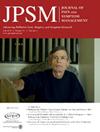利用“没有人会孤独死去”计划来支持濒死病人。
IF 3.5
2区 医学
Q2 CLINICAL NEUROLOGY
引用次数: 0
摘要
背景:20多年来,“无人孤独死去”(NODA)项目一直利用训练有素的志愿者为临终病人提供支持。目的:评估大型城市医疗中心的项目利用情况,可以为指导扩展和解决未满足的需求提供见解。方法:我们对华盛顿州西雅图港景医疗中心(HMC)一级创伤中心NODA项目的住院患者进行了回顾性队列研究。NODA项目自2012年以来一直在HMC运行,我们的队列包括到2020年的数据。我们从电子健康记录中提取患者人口统计、入院特征和项目利用指标,并使用描述性统计来总结来自死者的数据。结果:在研究期间,245例患者被转介到NODA项目,234例住院患者的数据可用。在这个项目中花费的平均时间为4天(SD 6), 37%的患者只参加了一天。大多数患者接受了野田志愿者的访问,尽管22%的患者没有自愿访问。在志愿者未到访的情况下,最常见的原因是患者在志愿者到达之前死亡(92%)。许多患者在住院期间进行了家访(56%)。结论:NODA方案适用于有家庭支持和无家庭支持的患者。由于转诊时间相对于死亡,一些患者无法从该计划中受益,这突出了早期咨询对最大化计划收益的重要性。本文章由计算机程序翻译,如有差异,请以英文原文为准。
Utilization of the No One Dies Alone Program to Support Dying Patients
Context
The No One Dies Alone (NODA) program has utilized trained volunteers to provide support to dying patients for over 20 years.
Objectives
Evaluating program utilization at a large, urban medical center can provide insights to guide expansion and address unmet needs.
Methods
We conducted a retrospective cohort study of hospitalized patients enrolled in the NODA program at Harborview Medical Center (HMC), a level I trauma center in Seattle, WA. The NODA program has been operating at HMC since 2012, and our cohort includes data through 2020. We extracted patient demographics, admission characteristics, and program utilization metrics from the electronic health record and used descriptive statistics to summarize the data from decedents.
Results
During the study period, 245 patients were referred to the NODA program, and data were available for 234 hospitalized patients. The average length of time spent in the program was four days (SD 6), with 37% of patients enrolled for only a single day. Most patients received a visit from NODA volunteers, although 22% had no volunteer visits. In cases where a volunteer did not visit, the most common reason was patient death prior to volunteer arrival (92%). Many patients had family visit during the hospitalization (56%).
Conclusion
The NODA program was utilized for patients with and without family support. Some patients were unable to benefit from the program due to timing of referral relative to death, highlighting the importance of early consultation to maximize program benefits.
求助全文
通过发布文献求助,成功后即可免费获取论文全文。
去求助
来源期刊
CiteScore
8.90
自引率
6.40%
发文量
821
审稿时长
26 days
期刊介绍:
The Journal of Pain and Symptom Management is an internationally respected, peer-reviewed journal and serves an interdisciplinary audience of professionals by providing a forum for the publication of the latest clinical research and best practices related to the relief of illness burden among patients afflicted with serious or life-threatening illness.

 求助内容:
求助内容: 应助结果提醒方式:
应助结果提醒方式:


